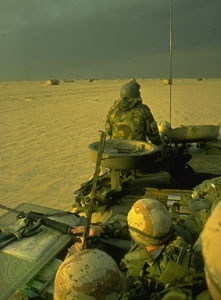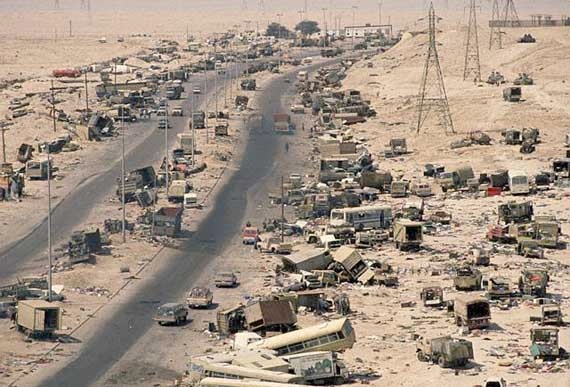Persian Gulf War
1991
also called Gulf War
 (1990–91), international (Middle East) conflict that was triggered by Iraq's invasion of Kuwait on August 2, 1990. Iraq's leader, Ṣaddām Ḥussein, ordered the invasion and occupation of Kuwait with the apparent aim of acquiring that nation's large oil reserves, canceling a large debt Iraq owed Kuwait, and expanding Iraqi power in the region. On August 3 the United Nations Security Council called for Iraq to withdraw from Kuwait, and on August 6 the council imposed a worldwide ban on trade with Iraq. (The Iraqi government responded by formally annexing Kuwait on August 8.) Iraq's invasion and the potential threat it then posed to Saudi Arabia, the world's largest oil producer and exporter, prompted the United States and its western European NATO (North Atlantic Treaty Organization) allies to rush troops to Saudi Arabia to deter a possible attack. Egypt and several other Arab nations joined the anti-Iraq coalition and contributed forces to the military buildup, known as Operation Desert Shield. Iraq meanwhile built up its occupying army in Kuwait to about 300,000 troops.
(1990–91), international (Middle East) conflict that was triggered by Iraq's invasion of Kuwait on August 2, 1990. Iraq's leader, Ṣaddām Ḥussein, ordered the invasion and occupation of Kuwait with the apparent aim of acquiring that nation's large oil reserves, canceling a large debt Iraq owed Kuwait, and expanding Iraqi power in the region. On August 3 the United Nations Security Council called for Iraq to withdraw from Kuwait, and on August 6 the council imposed a worldwide ban on trade with Iraq. (The Iraqi government responded by formally annexing Kuwait on August 8.) Iraq's invasion and the potential threat it then posed to Saudi Arabia, the world's largest oil producer and exporter, prompted the United States and its western European NATO (North Atlantic Treaty Organization) allies to rush troops to Saudi Arabia to deter a possible attack. Egypt and several other Arab nations joined the anti-Iraq coalition and contributed forces to the military buildup, known as Operation Desert Shield. Iraq meanwhile built up its occupying army in Kuwait to about 300,000 troops.On November 29 the UN Security Council (Security Council, United Nations) authorized the use of force against Iraq if it did not withdraw from Kuwait by January 15, 1991. By January 1991 the allied coalition against Iraq had reached a strength of 700,000 troops, including 540,000 U.S. personnel and smaller numbers of British, French, Egyptians, Saudis, Syrians, and several other national contingents. Ṣaddām steadfastly refused to withdraw Iraqi forces from Kuwait, however, which he maintained would remain a province of Iraq.
The Persian Gulf War began on January 16–17, 1991, with a massive U.S.-led air offensive against Iraq that continued throughout the war. Over the next few weeks, this sustained aerial bombardment, which had been named Operation Desert Storm, destroyed Iraq's air defenses before attacking its communications networks, government buildings, weapons plants, oil refineries, and bridges and roads. By mid February the allies had shifted their air attacks to Iraq's forward ground forces in Kuwait and southern Iraq, destroying their fortifications and tanks.
Operation Desert Sabre, a massive allied ground offensive, was launched northward from northeastern Saudi Arabia into Kuwait and southern Iraq on February 24, and within three days Arab and U.S. forces had retaken Kuwait city in the face of crumbling Iraqi resistance. Meanwhile, the main U.S. armoured thrust drove into Iraq some 120 miles (200 km) west of Kuwait and attacked Iraq's armoured reserves from the rear. By February 27 these forces had destroyed most of Iraq's elite Republican Guard units after the latter had tried to make a stand south of Al-Baṣrah in southeastern Iraq. By the time that U.S. President George Bush (Bush, George) declared a cease-fire for February 28, Iraqi resistance had completely collapsed.
 There are no official figures for the Iraqi military operation. Estimates of the number of Iraqi troops in the Kuwait theatre range from 180,000 to 630,000, and estimates of Iraqi military deaths range from 8,000 to 100,000. The allies, by contrast, lost about 300 troops in the conflict.
There are no official figures for the Iraqi military operation. Estimates of the number of Iraqi troops in the Kuwait theatre range from 180,000 to 630,000, and estimates of Iraqi military deaths range from 8,000 to 100,000. The allies, by contrast, lost about 300 troops in the conflict.The terms of the peace were, inter alia, that Iraq recognize Kuwait's sovereignty and that it divest itself of all weapons of mass destruction (i.e., nuclear, biological, and chemical weapons) and all missiles with ranges exceeding 90 miles (150 km). Pending complete compliance, economic sanctions would continue.
In the aftermath of Iraq's defeat, Kurds in the north of the country and Shīʿites in the south rose in a rebellion that was suppressed by Ṣaddām with great brutality. These actions prompted the allies to prohibit Iraqi aircraft from operating in designated “no-fly” zones over these areas. As the other allies gradually left the coalition, U.S. and British aircraft continued to patrol Iraqi skies, and UN inspectors sought to guarantee that all illicit weapons were destroyed. Iraq's failure to cooperate with inspectors led in 1998 to a brief resumption of hostilities (Operation Desert Fox). Iraq thereafter refused to readmit inspectors into the country, and regular exchanges of fire between Iraqi forces and U.S. and British aircraft over the no-fly zones continued into the 21st century. In 2002 the United States sponsored a new UN resolution calling for the return of weapons inspectors, who then reentered Iraq in November. Member states of the UN Security Council, however, differed in their opinion of the degree to which Iraq had cooperated with inspections. On March 17, 2003, the United States and the United Kingdom, which had begun to mass troops on Iraq's border, dispensed with further negotiations, and U.S. President George W. Bush (Bush, George W.)—seeking no further UN endorsement—issued an ultimatum demanding that Ṣaddām step down from power and leave Iraq within 48 hours or face war; he even suggested that if Ṣaddām did leave Iraq, U.S. forces might still be necessary to stabilize the region and to hunt for weapons of mass destruction. When Ṣaddām refused to leave, U.S. and allied forces launched an attack on Iraq on March 20 and thus began what became known as the Iraq War.
- zeon
- Zephaniah
- Zephaniah, Book of
- Zephyrinus, Saint
- zeppelin
- Zeppelin, Ferdinand, Graf (count) von
- Zeravshan Range
- Zeravshan River
- Zeraʿim
- Zermatt
- Zernike, Frits
- Zero
- Zero Mostel
- zero-point energy
- Zerubbabel
- Zeta-Jones, Catherine
- Zetkin, Clara
- Zetterling, Mai
- Zeus
- Zeus, Statue of
- Zeuxis
- Zewail, Ahmed H.
- Zeyārid Dynasty
- Zhabotinsky, Leonid Ivanovich
- zhang